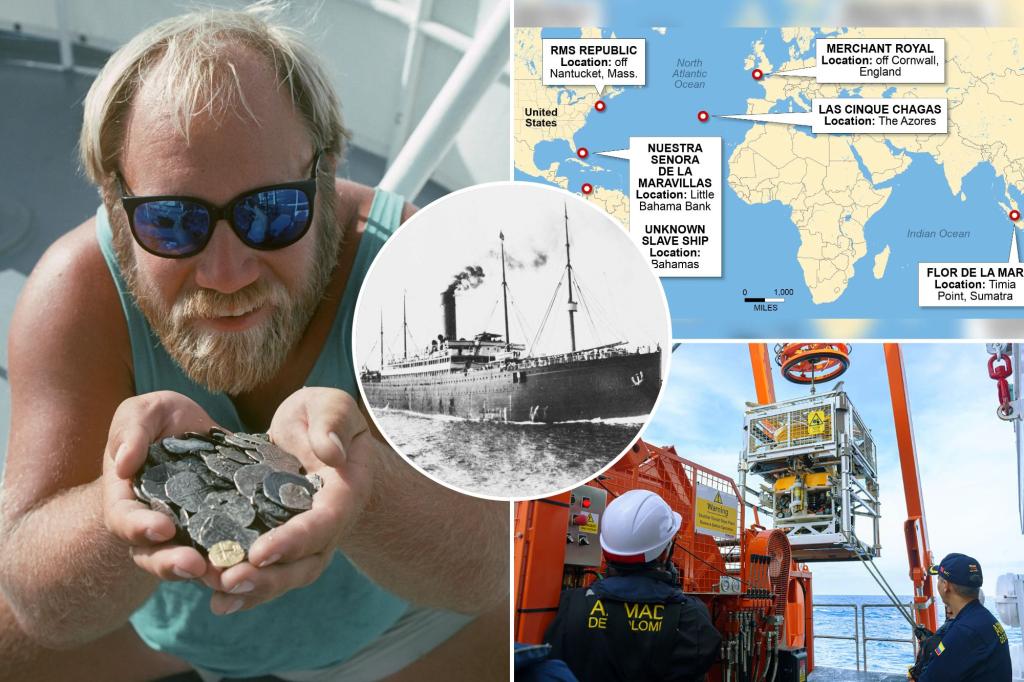
While the Colombian government hustles to recover an estimated $20 billion worth of undersea treasure from the 18th-century sunken ship the San José, around the Beru peninsula, treasure hunters around the world have their own booty to recover.
From the Bahamas to Newport to Portugal, it’s believed there are billions of dollars in loot on the ocean floor, just waiting to be scooped up.
Texas tycoon Carl Allen sold his trash-bag company in 2017 and invested millions into finding what he describes as a “motherlode” in sunken ships around the Bahamas.
Allen calls such adventures “an adult Easter egg hunt,” and oceanic archeologist Jim Sinclair, who works with Allen, insists it is about more than just the riches at stake.
“It is not just the money,” he told The Post, “For me it is about piecing together the past, using what was on the ship to find out about everyone from the wealthy passengers to the slaves.”
The most famous ship of all, the Titanic, was never on the hot list of serious under-sea treasure hunters.
“Gold was being exported from the United States at the time,” treasure hunter Martin Beyrie told The Post. “It was not coming into the country, which the Titanic was in the process of doing [traveling from Southampton, England, to New York City]. You’re not going to find a cache of treasure on that ship.”
Here are some of the hotspots on the radar of undersea treasure hunters.
Flor de la Mar (sank in 1511)
Location: Timia Point, off Sumatra
The Flor de la Mar was a Portuguese battleship, returning from a 1511 military campaign in Malacca, a major commercial hub in Southwest Malaysia. Loaded with spoils of war, including treasures that came from a ransacking of the Sultan of Malaca’s royal palace, the ship was done in by a nasty storm. Some 400 men are said to have lost their lives.
According to Discovery UK, some 80 tons of gold and other valuables — worth $2.5 billion in today’s money — went down with the ship.
Around 1992, Sinclair was working to bring up the booty. But, he told The Post, the Indonesian government got in the way of pulling the gold from its waters.
“They kept wanting higher and higher percentages of what we recovered,” said Sinclair, explaining that it ceased to be financially viable. “We had a good idea of where the ship was, but it felt like making a pot of oyster stew and finding that we had a very hungry friend.”
Las Cinque Chagas (sank in 1594)
Location: The Azores
Yet another doomed 16th-century vessel flying the Portuguese flag, Las Cinque Chagas was bringing back treasure and slaves from Goa, India, when three British ships attacked it in the mid-Atlantic.
The battle lasted for three days before Las Cinques became engulfed in flames and sank near the Azores (today, a seaside vacation spot). The ship’s precious cargo of diamonds, rubies, pearls and Portuguese coins is said to be worth more than $1 billion.
Though it sounds like plum pickings, there is one problem. Those riches are some 2,500 feet below the ocean’s surface — and, as Sinclair put it, “The deeper you go, the more expensive it gets.”
Nuestra Senora de la Maravillas (sank in 1656)
Location: Little Bahama Bank, northern Bahamas
The Spanish galleon (Lady of Wonders in English) was loaded with silver bars and coins, along with various gold items, from another sunken ship, the Jesus Maria de la Limpia Concepción, when it lost it bearings in the Bahama Channel and was rammed by a third boat — sending it into a collision with a reef.
“Half of it sunk and the other half floated off like a can of beer,” said Allen.
While an estimated half-a-billion dollars in silver, gold and jewelry were already salvaged from the ship by Spaniards soon after it sank, Allen believes that he will retrieve “a big part of what is left — up to triple that.”
That said, he added, “What’s frustrating, is that no one really knows what was on these ships. Whatever is on the manifest, there really was three times that in contraband. It was done to avoid paying taxes.”
So far, he said, “We’ve recovered thousands of artifacts but no motherlode. If we find everything, its worth can go into the billions.”
RMS Republic (sank in 1909)
Location: off Nantucket, Mass.
Three years before the Titanic went down, another luxe passenger ship owned by the same company, White Star, suffered a tragic fate.
After leaving New York City for Gibraltar, the RMS Republic collided with the SS Florida, which was loaded with immigrants coming stateside. Almost every passenger from the Republic — including members of the Mellon banking family — was rescued, save for six who died in the actual collision.
But 45 tons of gold, $800,000 in Navy pay and another $25 million from the sale of Russian bonds was lost to the bottom of the Atlantic.
Beyrie owns the wreck and, he told The Post, “Through research, we know where the boat is: 50 miles south of Nantucket. We want to be on site by June 1, 2024. It will take three to four years [to finish the excavation]. I want to validate proof through recovery. I want to see the cargo” — estimated to be worth more than $7 billion in today’s currency.
Merchant Royal (sank 1641)
Location: off the coast of Cornwall, England
The Merchant Royal had been used to facilitate trades with Spanish colonies in the New World in the first half of the 17th century. While docked in Spain for repairs, the ship’s captain cut a deal with that country’s government to deliver silver and gold to Antwerp — which added considerably to what was already a heavy load of precious metals on board.
The repairs, however, failed to resolve the Merchant Royal’s problems: As storms rolled in, leaks overtook the ship and the pumps failed to work. The vessel sank 34 miles from Land’s End, laden with gold and jewels.
The wreck has yet to be located. Whoever finds it will have access to some $1.25 billion in treasure.
Unknown slave ship (sank 1786)
Location: off the coast of the Bahamas
In 1786, this ship dropped off 800 slaves in the Caribbean and left with what Allen generally calls “a whole lot of gold coins” — before it met its fate by running into a reef and sinking.
Allen and his crew found four of the coins — just enough to tease the promise of more.
“They salvaged 100,000 coins out of 380,000. That leaves 280,000 coins to be found,” Allen told The Post. “We’re looking at it right now.”
Additional reporting by. Joshua Rhett Miller
This post was originally published on this site be sure to check out more of their content.






